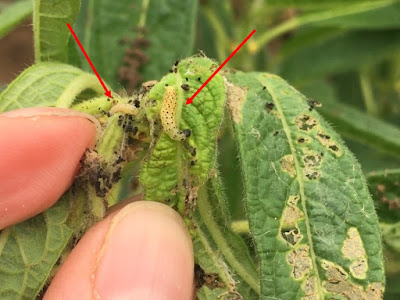For a few years Sesame grown in the Valley had few insect
pests and populations typically stayed well below management thresholds. Unfortunately, this has been changing over
the past few years and we are starting to see several insects cause significant
problems here and there.
One of these is the sesame leafroller, also called the sesame webworm or sesame capsule borer, Antigastra catalaunalis. It is a type of Crambid or snout moth. The adults are a cream to brownish moth with a
wingspan of a little over ½ inch. Forewings
have zigzag lines while the hind wings
are solid pale yellow. Adults feed on
plant nectar, live around 1 week and spend this time mating and locating host
plants where the female will oviposit, or deposit eggs, singly on the underside
of sesame leaves.
 |
| Sesame leafroller adult |
Eggs hatch in 2-3 days and larvae immediately begin
feeding. These tiny larvae (0.1 cm long)
will feed for 10-12 days, going through five instars, or molts, before reaching
larval maturity. As larvae grow, they
become yellowish to green with black spots and have a dark brown to black head
capsule. Mature larvae will reach 1 to
1.5 cm in length.
 |
| Sesame leafroller larvae (Photo by Danielle Sekula) |
Larvae are the damaging stage and feed on tender foliage,
pods, and shoots. As their name
suggests, they web the top leaves and terminal portion of the plant to provide
a protected location where they will feed, often destroying the apical meristem
of the plant.
The damage is easy to detect and is often full of little
black balls of frass, or excrement. If
you pull this webbing apart, you will find one or more larvae feeding. In many cases they can be seen between the
stem and pods where they bore holes into the developing pods and destroy the
seeds inside.
 |
| Showing webbing and feeding damage by sesame leafroller |
Once larval feeding is complete, they will pupate inside
webbed leaves, or may drop to the ground and pupate in the soil. Pupation lasts 5-6 days when adults will
emerge and begin the cycle again. It is
likely there will be at least several generations in the Valley so sesame
developing at different times can be infested.
 |
| Sesame leafroller pupa between stem and capsule |
We do not have a lot of information on control of this pest
in Texas. Studies done worldwide have
suggested that earlier planted sesame may not experience as high of levels of
infestation as later planted sesame.
This may be because several generations have built up resulting in larger
populations later in the season.
However, we have no data to show that this is the case in South Texas. This insect does have other reported hosts
including Amarathus species meaning it will have alternative
hosts when sesame is not available, and thus weed control may aid in keeping
webworm populations down.
We do not have established thresholds for this pest. However, because they are feeding directly on
flowers and pods, relatively low populations can likely cause significant yield
loss.
Insecticide applications are currently the best
recommendation for control. There are
relatively few insecticides labelled for use in sesame at this time. When spraying for this pest, keep in mind that while they
are often on the tip of the plant, they are also protected in webbing. For this reason, contact insecticides will
require plenty of carrier and good pressure to penetrate webbing and get the
insecticides to where larvae are feeding. Growers and consultants have reported
that an application of Chlorantaniliprole has provided good control of this
pest.






